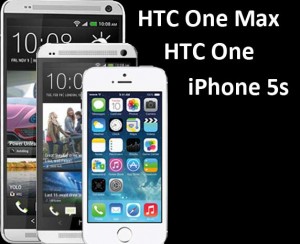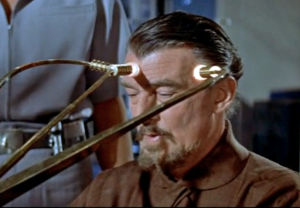
Diagonal Image Sizes: HTC One Max (5.9), HTC One (4.8), iPhone 5s (4.0) The iPhone 6 is rumored to have a 4.7 inch screen, bringing it into line with Android’s standard size.
Yesterday I went down to the Sprint store to pick up a replacement for my Android HTC One smartphone and came away with a sense that Apple’s iPhone has become a niche product.
My HTC One had developed an annoying inability to focus across it’s entire field of view so they replaced it. The new one works fine, thanks.
While they were loading my contacts in my phone, which was unnecessary since they’re backed up to my Google account, I browsed the displays and see if I could generate some techno-lust for a new phone. While there were Android phones in a wide range of sizes, from minis like Samsung’s Galaxy S4 mini (4.3” Super AMOLED display (960x 540)) to “Phablets,” like the LG Flex with its brilliant curved 6.0″ HD OLED Screen, I decided I was still happy with my current phone.
But I was dismayed by the iPhone offerings. Granted, there’s only one company putting out the iPhone, so they only need one display rather than the side by side displays for largely equivalent products from HTC, Motorola, Samsung, and Sprint, but instead of the range of phones available within each of those brands, Apple’s idea of variety gives you options in color, metal or plastic, and some performance specs.
All with a screen size that hasn’t changed much since it was an iPod. Granted that its resolution has been jumped up from the original 320×480 to 640 x 1136, but still only managing a 4 inch diagonal on the iPhone 5. Of course, Apple’s nobody’s fool, and it looks very much like their next phone, the iPhone 6, will have a 4.7 inch display, much more in line with the majority of Android devices.
But even so, Apple is playing catch-up.
The problem with cosying up to early adopting hipsters is that you build a barrier between yourself and the great unwashed, which may not be up for paying premium prices for the first ever gizmo, but make up for it by buying a lot more when the product becomes commoditized.
While I was entering the store, a sales rep was explaining to the guy in in front of me in the intake queue how he could free up memory on his phone, explaining some of the Android features at the same time, with the caveat, “Unless you switch over to an iPhone.”
To which he burst out with, “Hell no.” More of a wry disclaimer than a rant, but pretty much the last word on the subject.
Links / References
- http://www.forbes.com/sites/anthonykosner/2014/04/24/the-sleek-large-screen-iphone-6-emerges-as-the-leaks-suddenly-get-physical/
Comment and Share This Post:
 Border Crosser by Tom Doyle
Border Crosser by Tom Doyle


